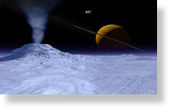
© JPL/NASA
Jets of water vapor blasting out of Saturn's moon Enceladus at supersonic speeds are coming from vents each about the size of a professional sports stadium, a new study says.
Scientists
first saw a plume of water vapor and dust shooting from the moon's south pole in 2005.
Research later determined that the water geysers are gushing out at about 1,000 miles (1,609 kilometers) an hour from a series of 100-mile-long (161-kilometer-long) fissures dubbed tiger stripes.
The new finding indicates that the gas and dust are escaping from relatively small vents along those fissures.
"We are making the distinction between the whole plume and individual jets in it, like streamers or searchlight beams," said team member Larry Esposito, of the University of Colorado in Boulder.
The researchers think the jets are formed when liquid water from pools not far beneath the icy moon's surface accelerates as vapor passes through a maze of nozzle-like channels before erupting into space.
"It's one more little piece of evidence that the source of the plume is liquid water," said lead study author Candice Hansen, a planetary scientist at NASA's Jet Propulsion Laboratory in Pasadena, California.
Swimming Pools and Ping PongThe Cassini spacecraft observed the way the plume dimmed starlight shining from behind as the probe zipped past Enceladus in 2005 and 2007.
The data allowed scientists to determine the vapor jets' speed and density as low as 9 miles (15 kilometers) above the surface. That, in turn, allowed them to calculate the likely size of the vents from which the vapor is emerging.
"It's certain the jets are not coming from the whole fissure," Esposito said.
Instead they are shooting out from regions that are no larger than 0.2 square miles (0.6 square kilometers), although the vents may be even smaller, depending on the temperature of the water vapor, the researchers note.
Overall, about 440 pounds (200 kilograms) of water are being blasted into space every second - roughly the equivalent of a residential swimming pool every few minutes.
But the amount observed in 2007 was less than that seen in 2005. That was a surprise, the University of Colorado's Esposito said, because in 2007, Enceladus was at a point in its orbit where scientists had calculated that tidal forces from Saturn would stretch the vents wider, increasing their flow.
Instead, the opposite appears to have happened, the scientists report in this week's issue of the journal
Nature."Sometimes you learn more by being wrong than by being right," study leader Hansen said.
She added that theoretical physicists are already looking at ways to refine their models of the moon to account for the new finding.
"It is the natural back-and-forth ping-pong [of science]," she said. "You make observations. People have hypotheses and theories about what's going on. [We] take more observations and figure out where we're on the right track and where we probably are not."
The finding does, however, bolster the case for subterranean liquid water, strengthening the argument that Enceladus might be one of the better places in the solar system to look for extraterrestrial life.
In a March 2008 flyby,
Cassini dipped into the plume and detected not only water vapor but also methane, carbon dioxide, and other organic molecules.
"We cannot say whether there is life or not," Hansen said. "But if we can conclude that there is liquid water, then we can say at least the ingredients are there."
Reader Comments
to our Newsletter